TOYOTA COROLLA 2022 (in English) Service Manual
Manufacturer: TOYOTA, Model Year: 2022, Model line: COROLLA, Model: TOYOTA COROLLA 2022Pages: 678, PDF Size: 147.24 MB
Page 41 of 678
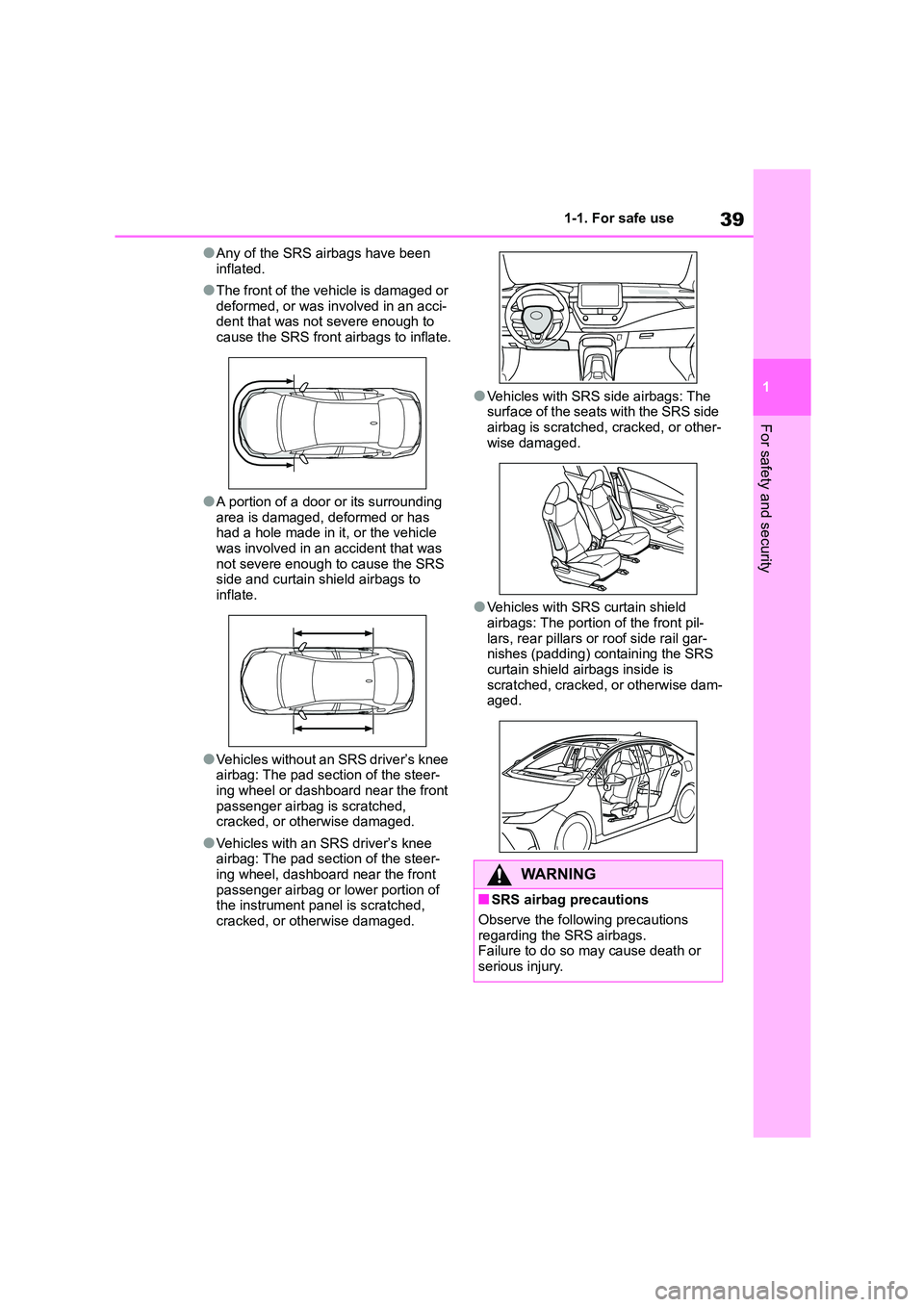
39
1
1-1. For safe use
For safety and security
●Any of the SRS airbags have been
inflated.
●The front of the vehicle is damaged or
deformed, or was involved in an acci- dent that was not severe enough to
cause the SRS front airbags to inflate.
●A portion of a door or its surrounding
area is damaged, deformed or has
had a hole made in it, or the vehicle was involved in an accident that was
not severe enough to cause the SRS
side and curtain shield airbags to inflate.
●Vehicles without an SRS driver’s knee airbag: The pad section of the steer-
ing wheel or dashboard near the front
passenger airbag is scratched, cracked, or otherwise damaged.
●Vehicles with an SRS driver’s knee airbag: The pad section of the steer-
ing wheel, dashboard near the front
passenger airbag or lower portion of the instrument panel is scratched,
cracked, or otherwise damaged.
●Vehicles with SRS side airbags: The
surface of the seats with the SRS side airbag is scratched, cracked, or other-
wise damaged.
●Vehicles with SRS curtain shield
airbags: The portion of the front pil-
lars, rear pillars or roof side rail gar- nishes (padding) containing the SRS
curtain shield airbags inside is
scratched, cracked, or otherwise dam- aged.
WA R N I N G
■SRS airbag precautions
Observe the following precautions
regarding the SRS airbags. Failure to do so may cause death or
serious injury.
Page 42 of 678
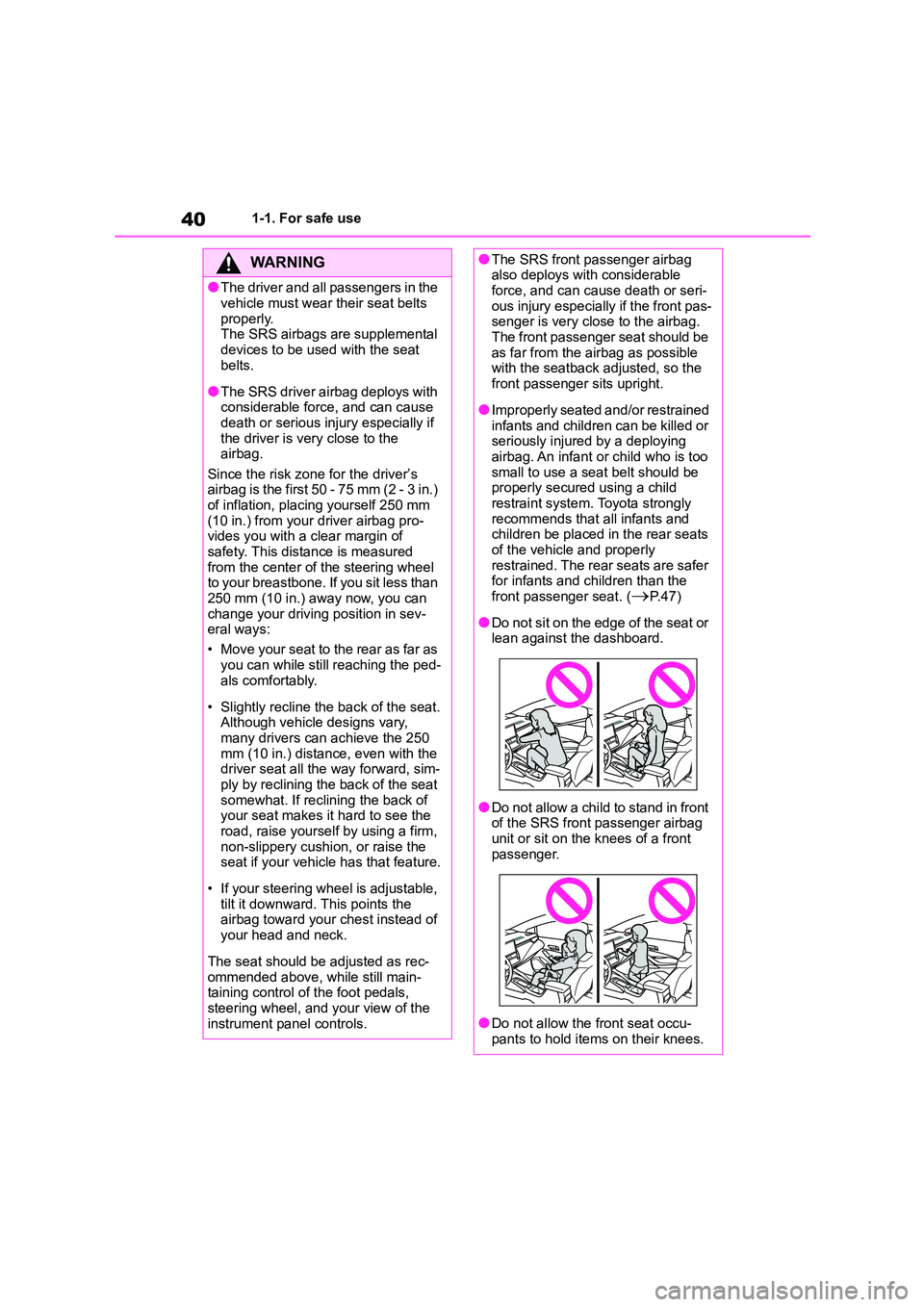
401-1. For safe use
WA R N I N G
●The driver and all passengers in the
vehicle must wear their seat belts
properly. The SRS airbags are supplemental
devices to be used with the seat
belts.
●The SRS driver airbag deploys with
considerable force, and can cause
death or serious injury especially if the driver is very close to the
airbag.
Since the risk zone for the driver’s airbag is the first 50 - 75 mm (2 - 3 in.)
of inflation, placing yourself 250 mm
(10 in.) from your driver airbag pro- vides you with a clear margin of
safety. This distance is measured
from the center of the steering wheel to your breastbone. If you sit less than
250 mm (10 in.) away now, you can
change your driving position in sev- eral ways:
• Move your seat to the rear as far as
you can while still reaching the ped- als comfortably.
• Slightly recline the back of the seat. Although vehicle designs vary,
many drivers can achieve the 250
mm (10 in.) distance, even with the driver seat all the way forward, sim-
ply by reclining the back of the seat
somewhat. If reclining the back of your seat makes it hard to see the
road, raise yourself by using a firm,
non-slippery cushion, or raise the seat if your vehicle has that feature.
• If your steering wheel is adjustable, tilt it downward. This points the
airbag toward your chest instead of
your head and neck.
The seat should be adjusted as rec-
ommended above, while still main- taining control of the foot pedals,
steering wheel, and your view of the
instrument panel controls.
●The SRS front passenger airbag also deploys with considerable
force, and can cause death or seri-
ous injury especially if the front pas- senger is very close to the airbag.
The front passenger seat should be
as far from the airbag as possible with the seatback adjusted, so the
front passenger sits upright.
●Improperly seated and/or restrained
infants and children can be killed or
seriously injured by a deploying airbag. An infant or child who is too
small to use a seat belt should be
properly secured using a child restraint system. Toyota strongly
recommends that all infants and
children be placed in the rear seats of the vehicle and properly
restrained. The rear seats are safer
for infants and children than the front passenger seat. (P. 4 7 )
●Do not sit on the edge of the seat or lean against the dashboard.
●Do not allow a child to stand in front of the SRS front passenger airbag
unit or sit on the knees of a front
passenger.
●Do not allow the front seat occu-
pants to hold items on their knees.
Page 43 of 678
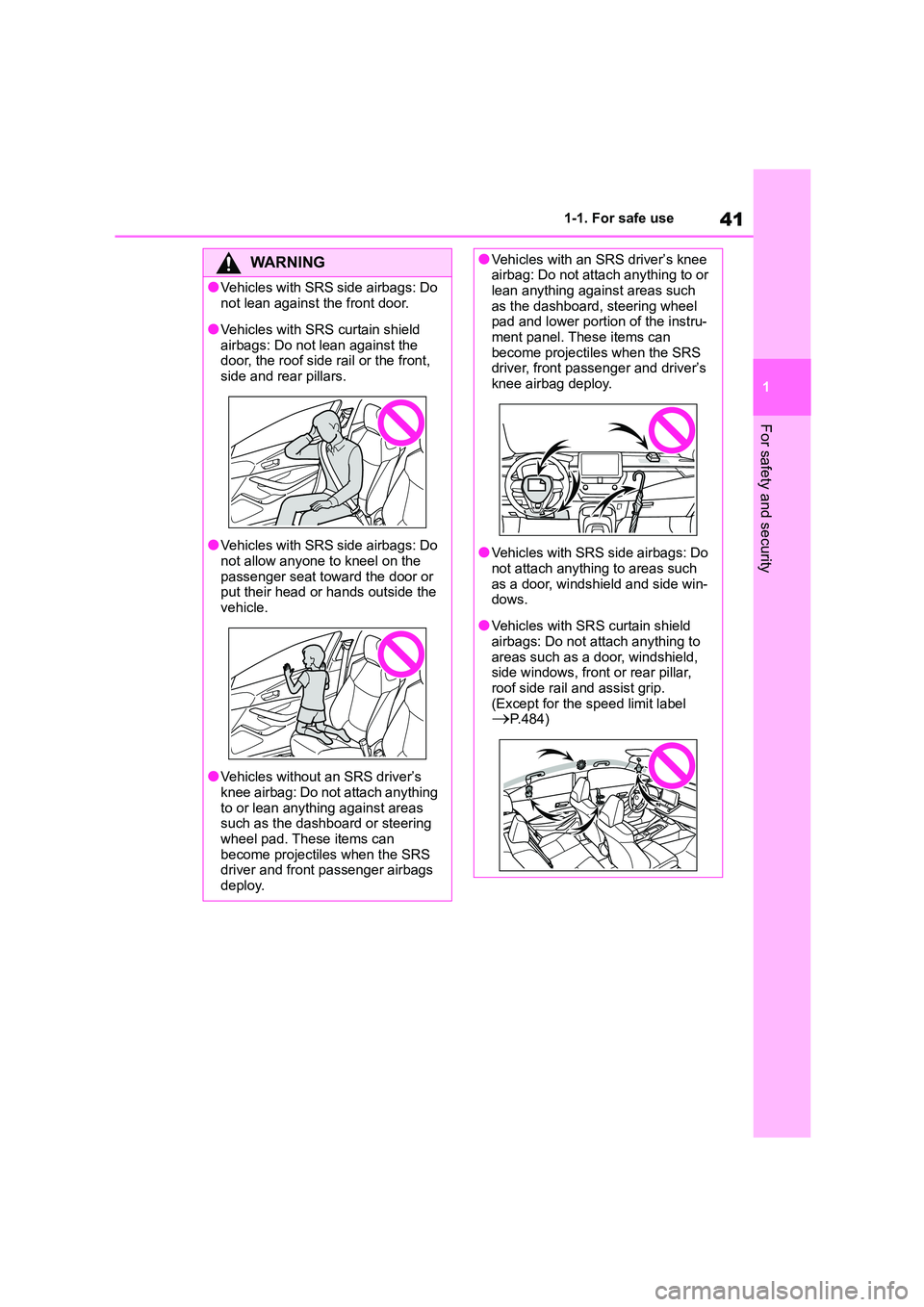
41
1
1-1. For safe use
For safety and security
WA R N I N G
●Vehicles with SRS side airbags: Do
not lean against the front door.
●Vehicles with SRS curtain shield
airbags: Do not lean against the
door, the roof side rail or the front, side and rear pillars.
●Vehicles with SRS side airbags: Do
not allow anyone to kneel on the passenger seat toward the door or
put their head or hands outside the
vehicle.
●Vehicles without an SRS driver’s
knee airbag: Do not attach anything to or lean anything against areas
such as the dashboard or steering
wheel pad. These items can become projectiles when the SRS
driver and front passenger airbags
deploy.
●Vehicles with an SRS driver’s knee airbag: Do not attach anything to or
lean anything against areas such
as the dashboard, steering wheel pad and lower portion of the instru-
ment panel. These items can
become projectiles when the SRS driver, front passe nger and driver’s
knee airbag deploy.
●Vehicles with SRS side airbags: Do
not attach anything to areas such
as a door, windshield and side win- dows.
●Vehicles with SRS curtain shield airbags: Do not attach anything to
areas such as a door, windshield,
side windows, front or rear pillar, roof side rail and assist grip.
(Except for the speed limit label
P.484)
Page 44 of 678
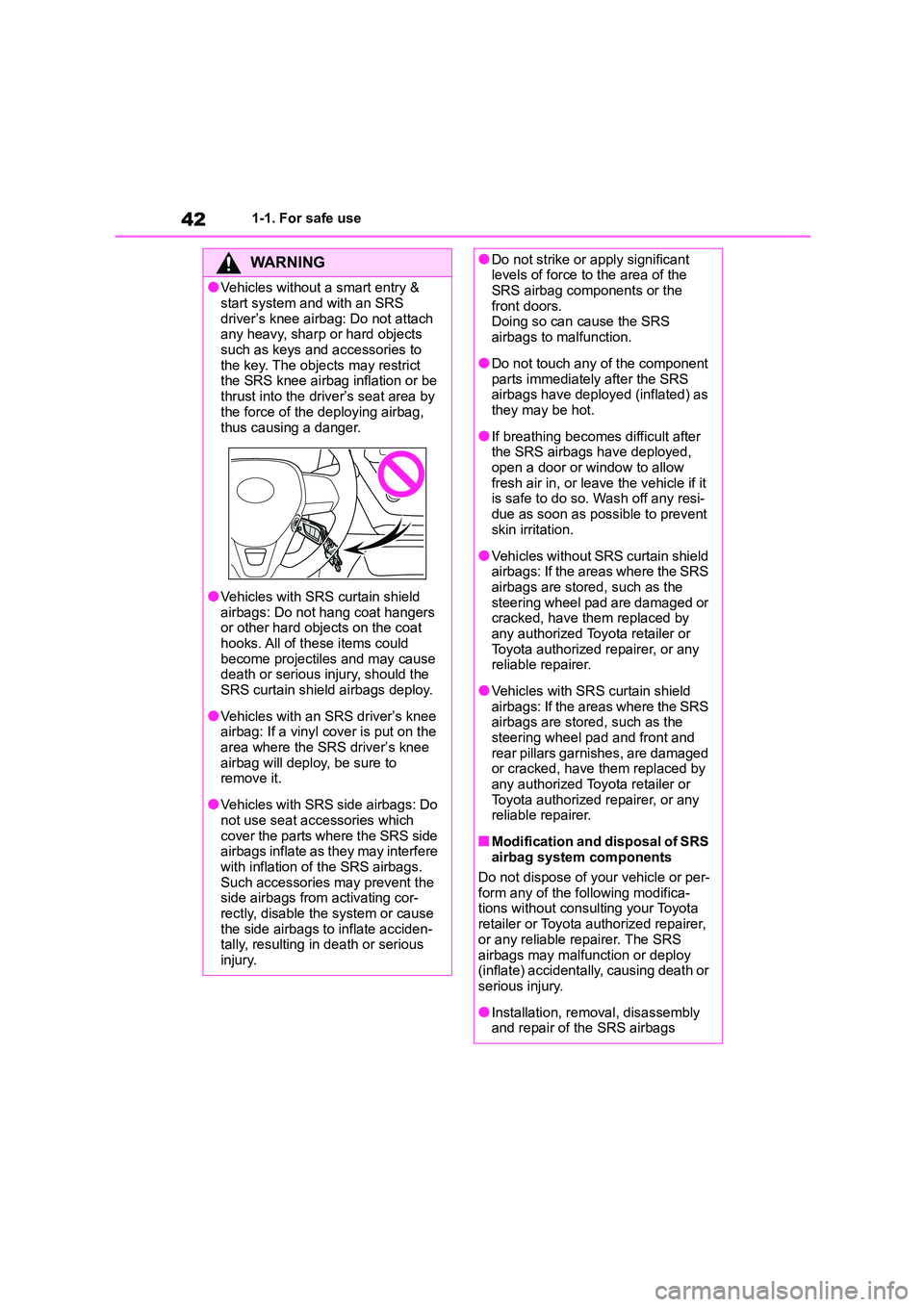
421-1. For safe use
WA R N I N G
●Vehicles without a smart entry &
start system and with an SRS
driver’s knee airbag: Do not attach any heavy, sharp or hard objects
such as keys and accessories to
the key. The objects may restrict the SRS knee airbag inflation or be
thrust into the driver’s seat area by
the force of the deploying airbag,
thus causing a danger.
●Vehicles with SRS curtain shield
airbags: Do not hang coat hangers or other hard objects on the coat
hooks. All of these items could
become projectiles and may cause death or serious injury, should the
SRS curtain shield airbags deploy.
●Vehicles with an SRS driver’s knee
airbag: If a vinyl cover is put on the
area where the SRS driver’s knee airbag will deploy, be sure to
remove it.
●Vehicles with SRS side airbags: Do
not use seat accessories which
cover the parts where the SRS side airbags inflate as they may interfere
with inflation of the SRS airbags.
Such accessories may prevent the side airbags from activating cor-
rectly, disable the system or cause
the side airbags to inflate acciden- tally, resulting in death or serious
injury.
●Do not strike or apply significant levels of force to the area of the
SRS airbag components or the
front doors. Doing so can cause the SRS
airbags to malfunction.
●Do not touch any of the component
parts immediately after the SRS
airbags have deployed (inflated) as they may be hot.
●If breathing becomes difficult after the SRS airbags have deployed,
open a door or window to allow
fresh air in, or leave the vehicle if it is safe to do so. Wash off any resi-
due as soon as possible to prevent
skin irritation.
●Vehicles without SRS curtain shield
airbags: If the areas where the SRS airbags are stored, such as the
steering wheel pad are damaged or
cracked, have them replaced by any authorized Toyota retailer or
Toyota authorized repairer, or any
reliable repairer.
●Vehicles with SRS curtain shield
airbags: If the areas where the SRS airbags are stored, such as the
steering wheel pad and front and
rear pillars garnishes, are damaged or cracked, have them replaced by
any authorized Toyota retailer or
Toyota authorized repairer, or any reliable repairer.
■Modification and disposal of SRS airbag system components
Do not dispose of your vehicle or per-
form any of the following modifica- tions without consulting your Toyota
retailer or Toyota authorized repairer,
or any reliable repairer. The SRS
airbags may malfunction or deploy (inflate) accidentally, causing death or
serious injury.
●Installation, remo val, disassembly
and repair of the SRS airbags
Page 45 of 678
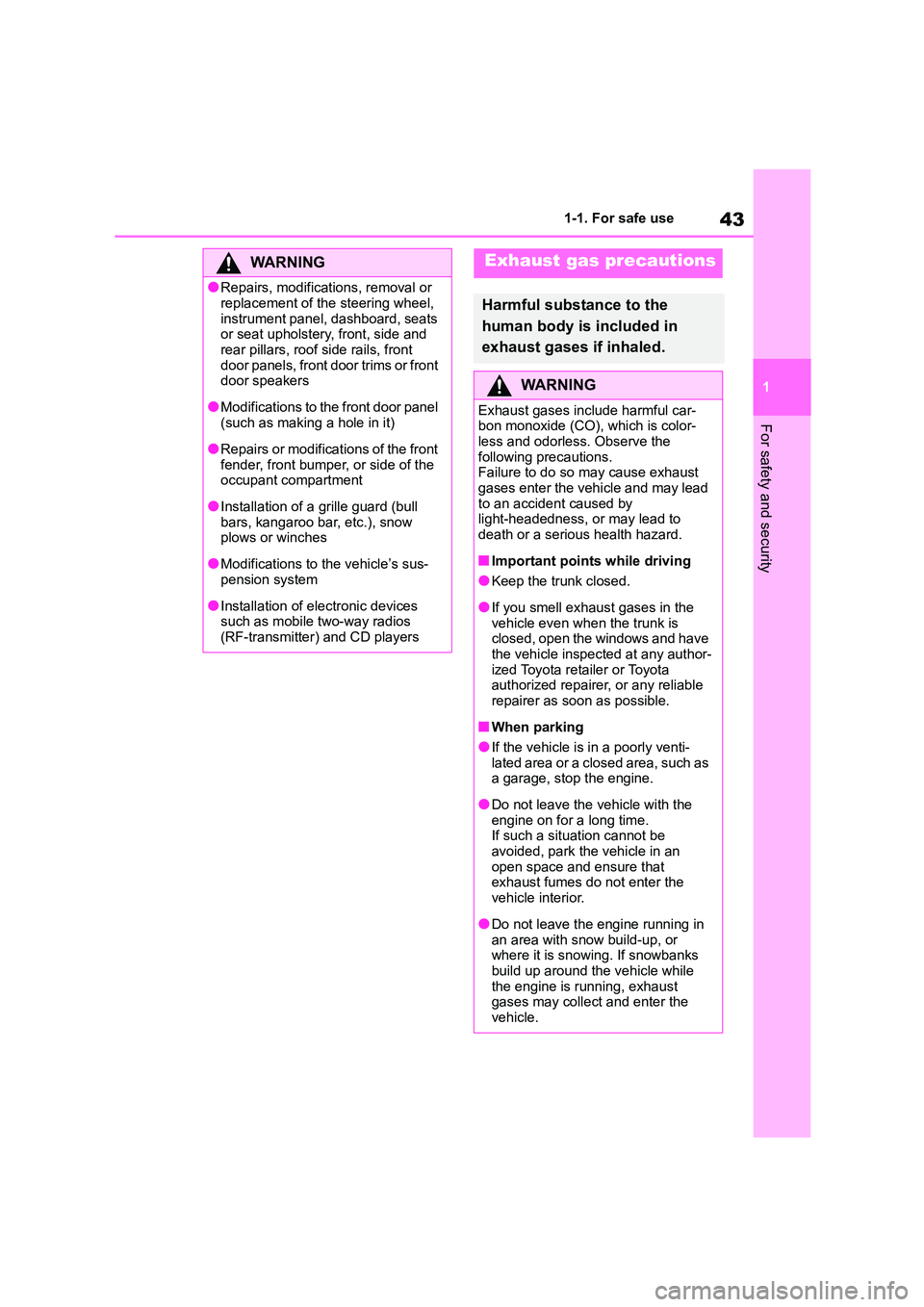
43
1
1-1. For safe use
For safety and security
WA R N I N G
●Repairs, modifications, removal or
replacement of the steering wheel,
instrument panel, dashboard, seats or seat upholstery, front, side and
rear pillars, roof side rails, front
door panels, front door trims or front door speakers
●Modifications to the front door panel
(such as making a hole in it)
●Repairs or modifications of the front
fender, front bumper, or side of the occupant compartment
●Installation of a grille guard (bull bars, kangaroo bar, etc.), snow
plows or winches
●Modifications to the vehicle’s sus-
pension system
●Installation of electronic devices
such as mobile two-way radios
(RF-transmitter) and CD players
Exhaust gas precautions
Harmful substance to the
human body is included in
exhaust gases if inhaled.
WA R N I N G
Exhaust gases include harmful car-
bon monoxide (CO), which is color-
less and odorless. Observe the following precautions.
Failure to do so may cause exhaust
gases enter the vehicle and may lead to an accident caused by
light-headedness, or may lead to
death or a serious health hazard.
■Important points while driving
●Keep the trunk closed.
●If you smell exhaust gases in the
vehicle even when the trunk is closed, open the windows and have
the vehicle inspected at any author-
ized Toyota retailer or Toyota authorized repairer, or any reliable
repairer as soon as possible.
■When parking
●If the vehicle is in a poorly venti-
lated area or a closed area, such as a garage, stop the engine.
●Do not leave the vehicle with the engine on for a long time.
If such a situation cannot be
avoided, park the vehicle in an open space and ensure that
exhaust fumes do not enter the
vehicle interior.
●Do not leave the engine running in
an area with snow build-up, or where it is snowing. If snowbanks
build up around the vehicle while
the engine is running, exhaust gases may collect and enter the
vehicle.
Page 46 of 678
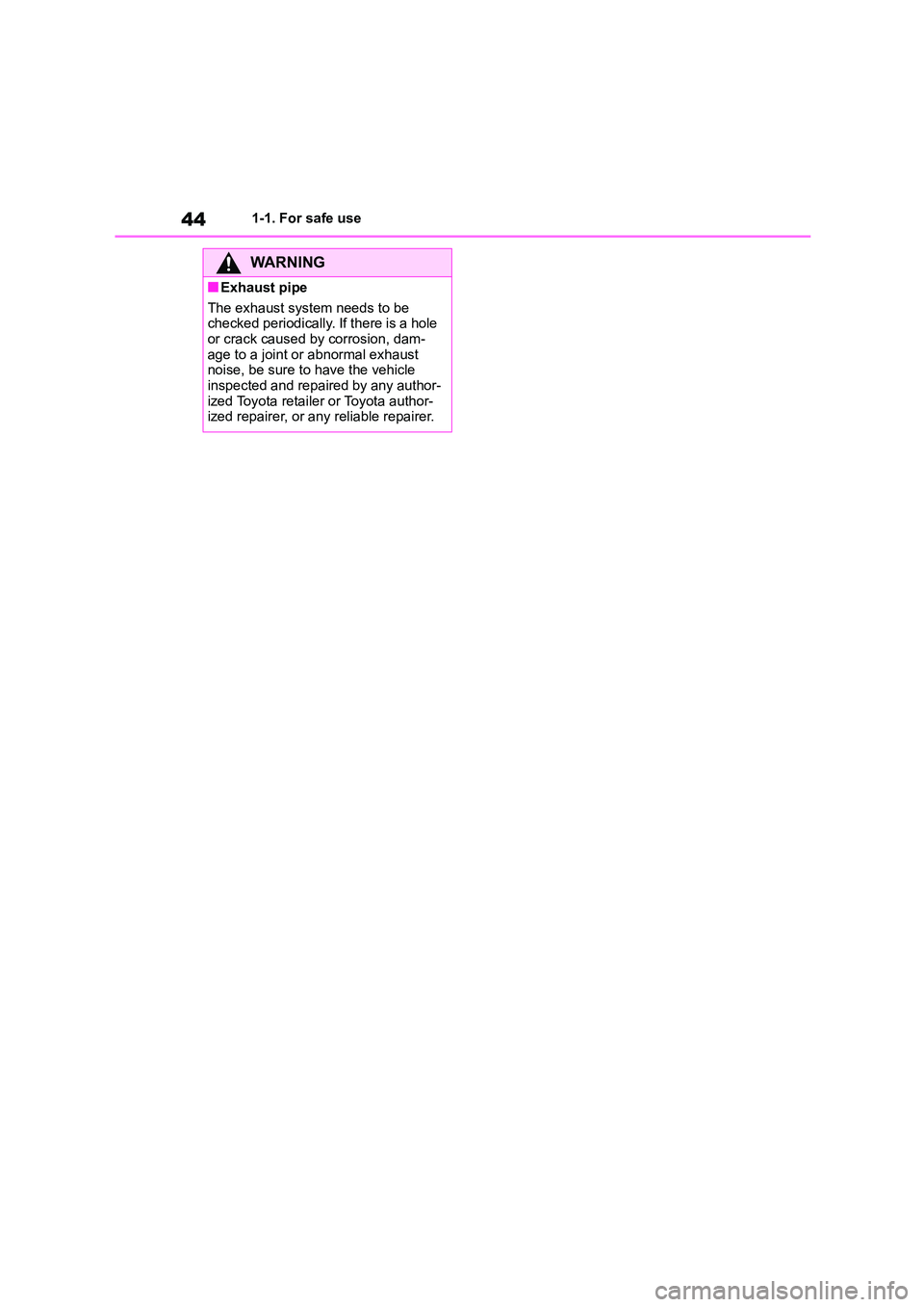
441-1. For safe use
WA R N I N G
■Exhaust pipe
The exhaust system needs to be
checked periodically. If there is a hole or crack caused by corrosion, dam-
age to a joint or abnormal exhaust
noise, be sure to have the vehicle inspected and repaired by any author-
ized Toyota retailer or Toyota author-
ized repairer, or any reliable repairer.
Page 47 of 678
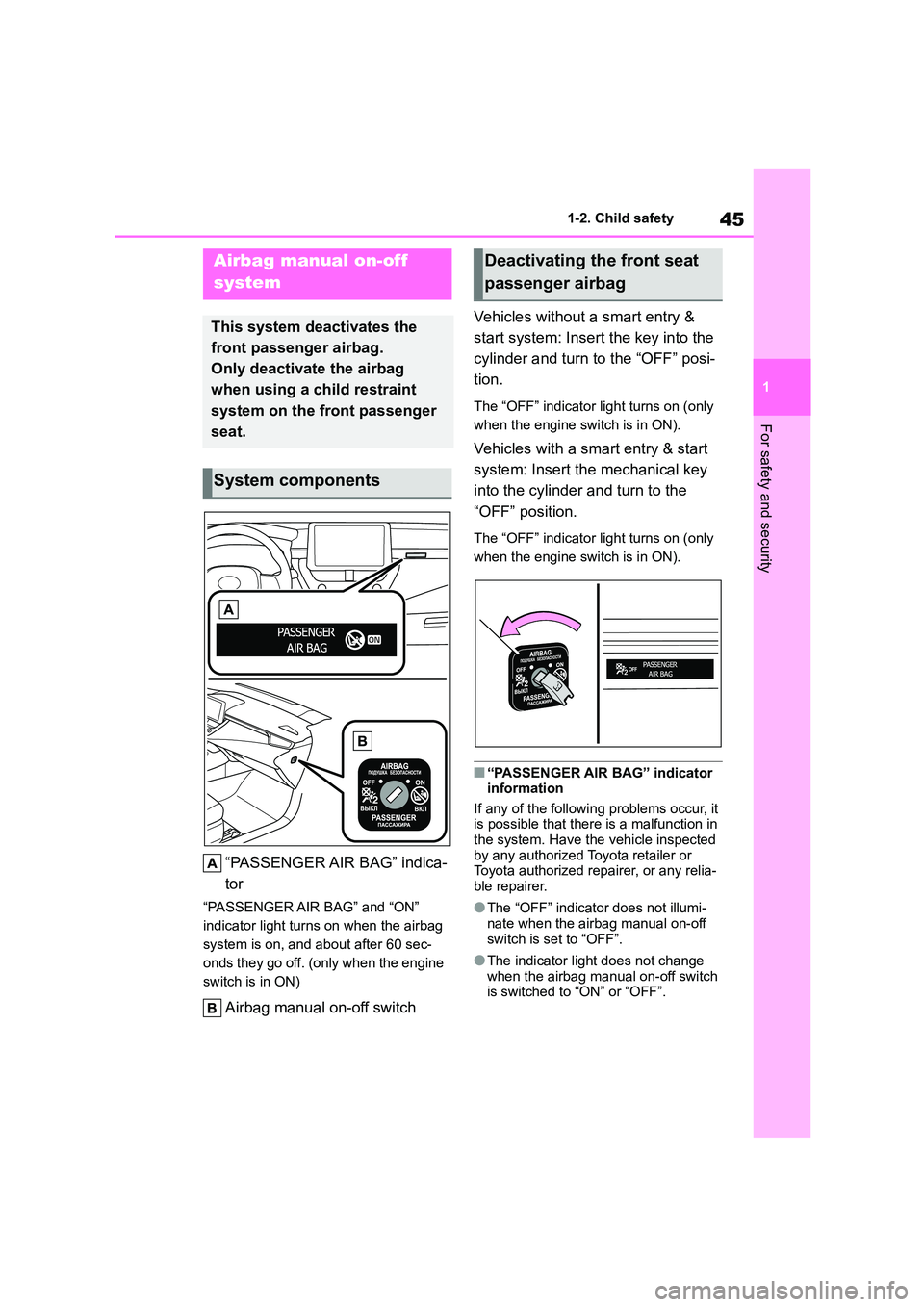
45
1
1-2. Child safety
For safety and security
1-2.Child safety
“PASSENGER AIR BAG” indica-
tor
“PASSENGER AIR BAG” and “ON”
indicator light turns on when the airbag
system is on, and about after 60 sec-
onds they go off. (only when the engine
switch is in ON)
Airbag manual on-off switch
Vehicles without a smart entry &
start system: Insert the key into the
cylinder and turn to the “OFF” posi-
tion.
The “OFF” indicator light turns on (only
when the engine switch is in ON).
Vehicles with a smart entry & start
system: Insert the mechanical key
into the cylinder and turn to the
“OFF” position.
The “OFF” indicator light turns on (only
when the engine switch is in ON).
■“PASSENGER AIR BAG” indicator information
If any of the following problems occur, it
is possible that there is a malfunction in the system. Have the vehicle inspected
by any authorized Toyota retailer or
Toyota authorized repairer, or any relia- ble repairer.
●The “OFF” indicator does not illumi-
nate when the airbag manual on-off switch is set to “OFF”.
●The indicator light does not change when the airbag manual on-off switch
is switched to “ON” or “OFF”.
Airbag manual on-off
system
This system deactivates the
front passenger airbag.
Only deactivate the airbag
when using a child restraint
system on the front passenger
seat.
System components
Deactivating the front seat
passenger airbag
Page 48 of 678
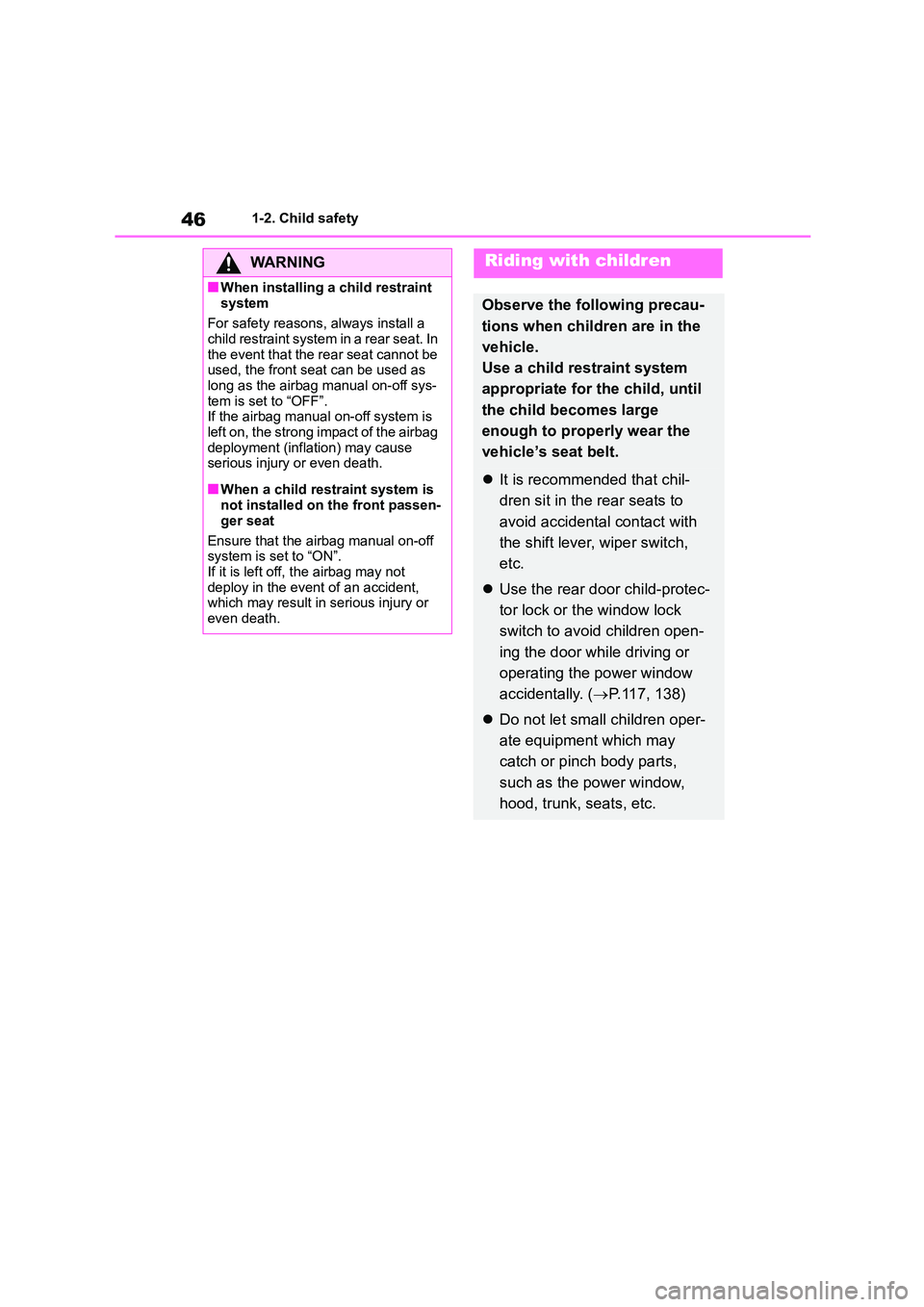
461-2. Child safety
WA R N I N G
■When installing a child restraint
system
For safety reasons, always install a child restraint system in a rear seat. In
the event that the rear seat cannot be
used, the front seat can be used as long as the airbag manual on-off sys-
tem is set to “OFF”.
If the airbag manual on-off system is
left on, the strong impact of the airbag deployment (inflation) may cause
serious injury or even death.
■When a child restraint system is
not installed on the front passen-
ger seat
Ensure that the airbag manual on-off
system is set to “ON”.
If it is left off, the airbag may not deploy in the event of an accident,
which may result in serious injury or
even death.
Riding with children
Observe the following precau-
tions when children are in the
vehicle.
Use a child restraint system
appropriate for the child, until
the child becomes large
enough to properly wear the
vehicle’s seat belt.
It is recommended that chil-
dren sit in the rear seats to
avoid accidental contact with
the shift lever, wiper switch,
etc.
Use the rear door child-protec-
tor lock or the window lock
switch to avoid children open-
ing the door while driving or
operating the power window
accidentally. ( P.117, 138)
Do not let small children oper-
ate equipment which may
catch or pinch body parts,
such as the power window,
hood, trunk, seats, etc.
Page 49 of 678
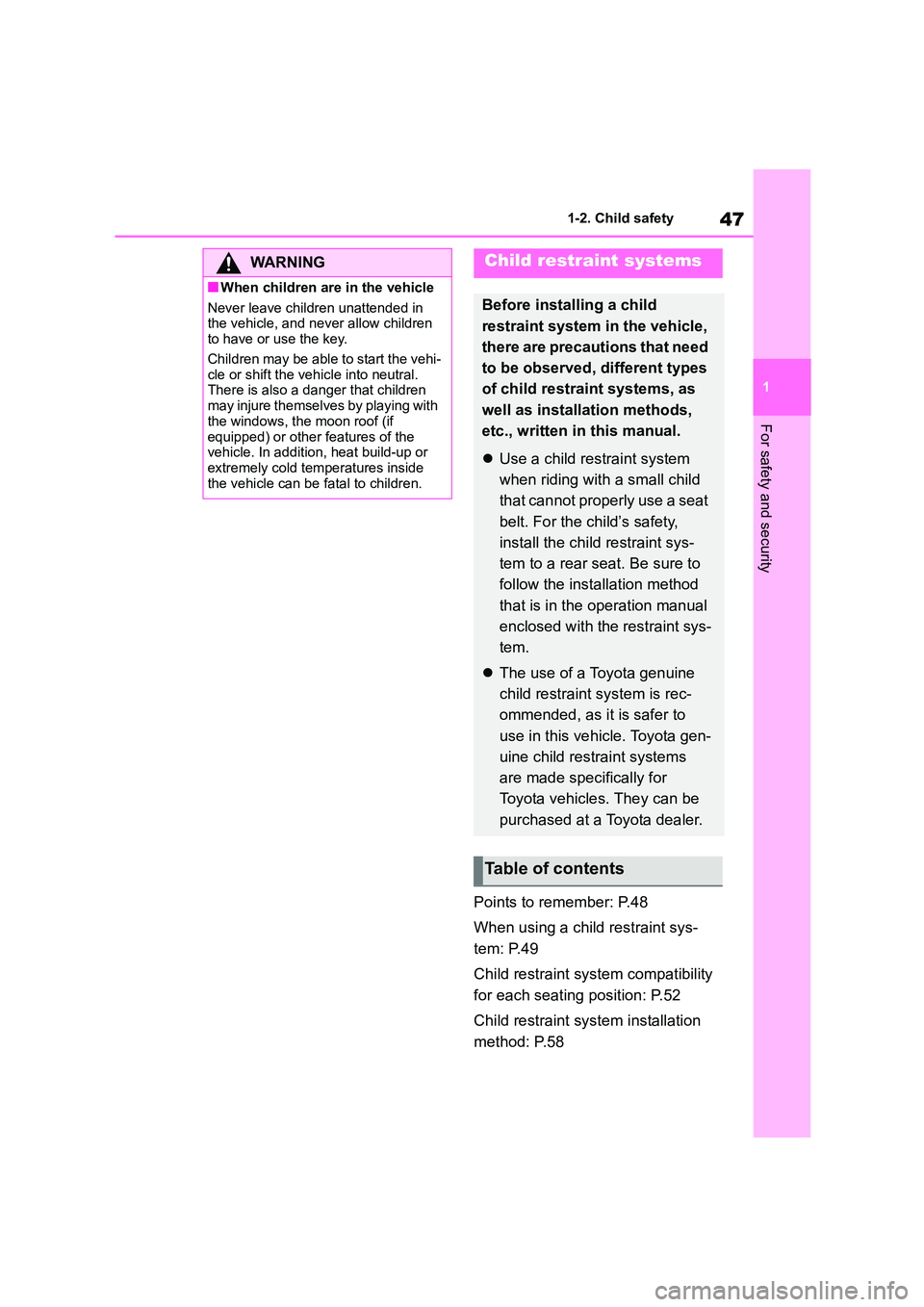
47
1
1-2. Child safety
For safety and security
Points to remember: P.48
When using a child restraint sys-
tem: P.49
Child restraint sys tem compatibility
for each seating position: P.52
Child restraint sys tem installation
method: P.58
WA R N I N G
■When children are in the vehicle
Never leave children unattended in
the vehicle, and never allow children to have or use the key.
Children may be able to start the vehi-
cle or shift the vehicle into neutral. There is also a danger that children
may injure themselves by playing with
the windows, the moon roof (if
equipped) or other features of the vehicle. In addition, heat build-up or
extremely cold temperatures inside
the vehicle can be fatal to children.
Child restraint systems
Before installing a child
restraint system in the vehicle,
there are precautions that need
to be observed, different types
of child restraint systems, as
well as installation methods,
etc., written in this manual.
Use a child restraint system
when riding with a small child
that cannot properly use a seat
belt. For the child’s safety,
install the child restraint sys-
tem to a rear se at. Be sure to
follow the insta llation method
that is in the operation manual
enclosed with the restraint sys-
tem.
The use of a Toyota genuine
child restraint system is rec-
ommended, as it is safer to
use in this vehicle. Toyota gen-
uine child restraint systems
are made specifically for
Toyota vehicles. They can be
purchased at a Toyota dealer.
Table of contents
Page 50 of 678

481-2. Child safety
• Fixed with a seat belt: P.59
• Fixed with an ISOFIX lower
anchorage: P.61
• Using a top tether anchorage:
P. 6 2
Prioritize and observe the warn-
ings, as well as the laws and reg-
ulations for child restraint
systems.
Use a child restraint system until
the child becomes large enough
to properly wear the vehicle’s
seat belt.
Choose a child restraint system
appropriate to the age and size
of the child.
Note that not all child restraint
systems can fit in all vehicles.
Before using or purchasing a
child restraint system, check the
compatibility of th e child restraint
system with seat positions.
( P. 5 2 )
Points to remember
WA R N I N G
■When a child is riding
Observe the following precautions.
Failure to do so may result in death or
serious injury.
●For effective protection in automo- bile accidents and sudden stops, a
child must be properly restrained,
using a seat belt or child restraint system which is corr ectly installed.
For installation details, refer to the
operation manual enclosed with the child restraint system. General
installation instruction is provided in
this manual.
●Toyota strongly urges the use of a
proper child rest raint system that conforms to the weight and size of
the child, installed on the rear seat.
According to accident statistics, the child is safer when properly
restrained in the rear seat than in
the front seat.
●Holding a child in your or someone
else’s arms is not a substitute for a child restraint system. In an acci-
dent, the child can be crushed
against the windshield or between the holder and the interior of the
vehicle.
■Handling the child restraint sys-
tem
If the child restraint system is not properly fixed in place, the child or
other passengers may be seriously
injured or even killed in the event of sudden braking, sudden swerving, or
an accident.
●If the vehicle were to receive a
strong impact from an accident,
etc., it is possible that the child restraint system has damage that is
not readily visible. In such cases,
do not reuse the restraint system.